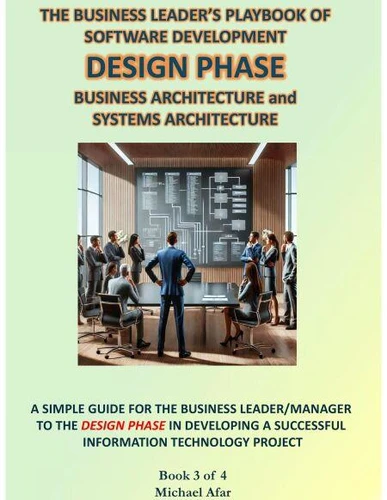Nouveauté
Design Phase. The Business Leader's Playbook of Software Development, #3
Par :Formats :
Disponible dans votre compte client Decitre ou Furet du Nord dès validation de votre commande. Le format ePub est :
- Compatible avec une lecture sur My Vivlio (smartphone, tablette, ordinateur)
- Compatible avec une lecture sur liseuses Vivlio
- Pour les liseuses autres que Vivlio, vous devez utiliser le logiciel Adobe Digital Edition. Non compatible avec la lecture sur les liseuses Kindle, Remarkable et Sony
 , qui est-ce ?
, qui est-ce ?Notre partenaire de plateforme de lecture numérique où vous retrouverez l'ensemble de vos ebooks gratuitement
Pour en savoir plus sur nos ebooks, consultez notre aide en ligne ici
- FormatePub
- ISBN8231957538
- EAN9798231957538
- Date de parution04/07/2025
- Protection num.pas de protection
- Infos supplémentairesepub
- ÉditeurWalzone Press
Résumé
Business leaders and managers are expected to not only understand the goals of their organizations but also effectively collaborate with technical teams throughout the Software Development Life Cycle (SDLC). Design Phase - Business Architecture and System Architecture is an essential resource designed to help leaders actively engage with consultants and technical staff during this pivotal stage. The book explains the use of enterprise and business architecture frameworks, such as the Zachman Framework, to provide clarity on how different components of a business-data, function, people, network, and motivation-are represented and modeled in system design.
The book emphasizes the role of business leaders in system architecture and details how their involvement can impact system design from defining business requirements to participating in governance and decision-making. The Table of Contents of the book comprises:I. GlossaryII. IntroductionAbout this PublicationIII. Information Technology Project PhasesIV. Impact of AI on SDLC1. System Development Phases2. Design PhaseA. Overview of the Design PhaseB. About Use Cases2.1. Enterprise Architecture2.2. Business Architecture2.2.1. Row 1 - Contextual (Planner's View)2.2.1.1. Row 1 - Column 1 - Data2.2.1.2. Row 1 - Column 2 - Function2.2.1.3. Row 1 - Column 3 - Network2.2.1.4. Row 1 - Column 4 - People2.2.1.5. Row 1 - Column 5 - Time2.2.1.6. Row 1 - Column 6 - Motivation (Why)2.2.2. Row 2 - Conceptual (Owner's View)2.2.2.1. Row 2 - Column 1 - Data2.2.2.2. Row 2 - Column 2 - Function2.2.2.3. Row 2 - Column 3 - Network2.2.2.4. Row 2 - Column 4 - People2.2.2.5. Row 2 - Column 5 - Time2.2.2.6. Row 2 - Column 6 - Motivation (Why)2.3. System Architecture2.3.1. Aspects of Business Involvement in System Architecture1.
Defining Business Requirements2. Setting Strategic Objectives3. Participation in Design and Planning4. Governance and Decision-Making5. Change Management and User Adoption6. Continuous Improvement and Feedback2.3.2. Zachman Framework Business Involvement in System Architecture1. Data Architecture (Column 1 - What)2. Application Architecture (Column 2 - How)3. Network Architecture (Column 3 - Where)4. User Architecture (Column 4 - Who)5. Process Architecture (Column 5 - When)6. Motivation Architecture (Column 6 - Why)2.3.3. Business Leaders Must Get Involved in System ArchitectureAppendix A - Use Cases
The book emphasizes the role of business leaders in system architecture and details how their involvement can impact system design from defining business requirements to participating in governance and decision-making. The Table of Contents of the book comprises:I. GlossaryII. IntroductionAbout this PublicationIII. Information Technology Project PhasesIV. Impact of AI on SDLC1. System Development Phases2. Design PhaseA. Overview of the Design PhaseB. About Use Cases2.1. Enterprise Architecture2.2. Business Architecture2.2.1. Row 1 - Contextual (Planner's View)2.2.1.1. Row 1 - Column 1 - Data2.2.1.2. Row 1 - Column 2 - Function2.2.1.3. Row 1 - Column 3 - Network2.2.1.4. Row 1 - Column 4 - People2.2.1.5. Row 1 - Column 5 - Time2.2.1.6. Row 1 - Column 6 - Motivation (Why)2.2.2. Row 2 - Conceptual (Owner's View)2.2.2.1. Row 2 - Column 1 - Data2.2.2.2. Row 2 - Column 2 - Function2.2.2.3. Row 2 - Column 3 - Network2.2.2.4. Row 2 - Column 4 - People2.2.2.5. Row 2 - Column 5 - Time2.2.2.6. Row 2 - Column 6 - Motivation (Why)2.3. System Architecture2.3.1. Aspects of Business Involvement in System Architecture1.
Defining Business Requirements2. Setting Strategic Objectives3. Participation in Design and Planning4. Governance and Decision-Making5. Change Management and User Adoption6. Continuous Improvement and Feedback2.3.2. Zachman Framework Business Involvement in System Architecture1. Data Architecture (Column 1 - What)2. Application Architecture (Column 2 - How)3. Network Architecture (Column 3 - Where)4. User Architecture (Column 4 - Who)5. Process Architecture (Column 5 - When)6. Motivation Architecture (Column 6 - Why)2.3.3. Business Leaders Must Get Involved in System ArchitectureAppendix A - Use Cases
Business leaders and managers are expected to not only understand the goals of their organizations but also effectively collaborate with technical teams throughout the Software Development Life Cycle (SDLC). Design Phase - Business Architecture and System Architecture is an essential resource designed to help leaders actively engage with consultants and technical staff during this pivotal stage. The book explains the use of enterprise and business architecture frameworks, such as the Zachman Framework, to provide clarity on how different components of a business-data, function, people, network, and motivation-are represented and modeled in system design.
The book emphasizes the role of business leaders in system architecture and details how their involvement can impact system design from defining business requirements to participating in governance and decision-making. The Table of Contents of the book comprises:I. GlossaryII. IntroductionAbout this PublicationIII. Information Technology Project PhasesIV. Impact of AI on SDLC1. System Development Phases2. Design PhaseA. Overview of the Design PhaseB. About Use Cases2.1. Enterprise Architecture2.2. Business Architecture2.2.1. Row 1 - Contextual (Planner's View)2.2.1.1. Row 1 - Column 1 - Data2.2.1.2. Row 1 - Column 2 - Function2.2.1.3. Row 1 - Column 3 - Network2.2.1.4. Row 1 - Column 4 - People2.2.1.5. Row 1 - Column 5 - Time2.2.1.6. Row 1 - Column 6 - Motivation (Why)2.2.2. Row 2 - Conceptual (Owner's View)2.2.2.1. Row 2 - Column 1 - Data2.2.2.2. Row 2 - Column 2 - Function2.2.2.3. Row 2 - Column 3 - Network2.2.2.4. Row 2 - Column 4 - People2.2.2.5. Row 2 - Column 5 - Time2.2.2.6. Row 2 - Column 6 - Motivation (Why)2.3. System Architecture2.3.1. Aspects of Business Involvement in System Architecture1.
Defining Business Requirements2. Setting Strategic Objectives3. Participation in Design and Planning4. Governance and Decision-Making5. Change Management and User Adoption6. Continuous Improvement and Feedback2.3.2. Zachman Framework Business Involvement in System Architecture1. Data Architecture (Column 1 - What)2. Application Architecture (Column 2 - How)3. Network Architecture (Column 3 - Where)4. User Architecture (Column 4 - Who)5. Process Architecture (Column 5 - When)6. Motivation Architecture (Column 6 - Why)2.3.3. Business Leaders Must Get Involved in System ArchitectureAppendix A - Use Cases
The book emphasizes the role of business leaders in system architecture and details how their involvement can impact system design from defining business requirements to participating in governance and decision-making. The Table of Contents of the book comprises:I. GlossaryII. IntroductionAbout this PublicationIII. Information Technology Project PhasesIV. Impact of AI on SDLC1. System Development Phases2. Design PhaseA. Overview of the Design PhaseB. About Use Cases2.1. Enterprise Architecture2.2. Business Architecture2.2.1. Row 1 - Contextual (Planner's View)2.2.1.1. Row 1 - Column 1 - Data2.2.1.2. Row 1 - Column 2 - Function2.2.1.3. Row 1 - Column 3 - Network2.2.1.4. Row 1 - Column 4 - People2.2.1.5. Row 1 - Column 5 - Time2.2.1.6. Row 1 - Column 6 - Motivation (Why)2.2.2. Row 2 - Conceptual (Owner's View)2.2.2.1. Row 2 - Column 1 - Data2.2.2.2. Row 2 - Column 2 - Function2.2.2.3. Row 2 - Column 3 - Network2.2.2.4. Row 2 - Column 4 - People2.2.2.5. Row 2 - Column 5 - Time2.2.2.6. Row 2 - Column 6 - Motivation (Why)2.3. System Architecture2.3.1. Aspects of Business Involvement in System Architecture1.
Defining Business Requirements2. Setting Strategic Objectives3. Participation in Design and Planning4. Governance and Decision-Making5. Change Management and User Adoption6. Continuous Improvement and Feedback2.3.2. Zachman Framework Business Involvement in System Architecture1. Data Architecture (Column 1 - What)2. Application Architecture (Column 2 - How)3. Network Architecture (Column 3 - Where)4. User Architecture (Column 4 - Who)5. Process Architecture (Column 5 - When)6. Motivation Architecture (Column 6 - Why)2.3.3. Business Leaders Must Get Involved in System ArchitectureAppendix A - Use Cases





